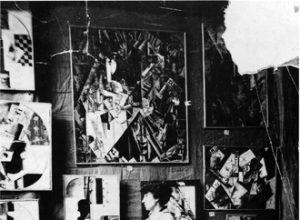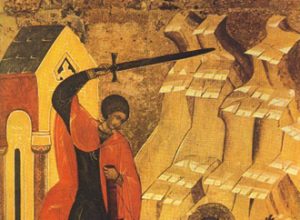Icon comes from the Greek word for religious images of all kinds, in all materials, and of every dimension. Objects of worship but also objets d’art, icons are linked to the Orthodox faith but also to the history of art. They are the tokens of a worldview that has inspired theologians as well as artists. In this regard, Jean-Claude Marcadé reminds us of the importance of Kandinsky’s discovery of painted and printed icons in those izbas of Northern Russia in which the painter says he learned “not to look at the picture sidelong, but to move within the picture, to live in the picture.” He offers us the keys to understanding the contemporary debate within post-Soviet Russia, where the dual status of icons remains of topical interest. Some Orthodox believers would like to see these venerated images returned to the churches, whereas they had previously been moved to museums where one sometimes see the faithful come to pray. Taking the writings of Nicolai Tarabukin (1889-1956) and Father Pavel Florensky (1882-1937) as their starting points, Marcadé, a great specialist of Russian art, as well as Igor Sokologorsky, a philosopher, study the interpretative aspect of these forms in traditional as well as modern art.
Laurence Bertrand Dorléac
Seminar of March 5th 2009
Pavel Florensky:
Icons and Worldviews
Igor Sokologorsky
Pavel Florensky (1882-1937) was one of the main Russian theologians of the twentieth century. His principal work is The Pillar and Ground of the Truth: An Essay in Orthodox Theodicy in Twelve Letters, which appeared in 1924. After the revolution, in 1918, Florensky was named scholarly secretary for a commission created to reflect on the appropriate fate for the Orthodox Church icons preserved at the Trinity Lavra of St. Sergius. Should they be considered mere objects of worship or do they have some other interest that would make them worth saving? Florensky drafted several texts for this commission, and in particular Inverse Perspective. This opuscule turns inside out the Realist complaint one would be tempted to bring against medieval Russian icons. Florensky maintains that such icons offer a vision of things that is in greater conformity with reality than the linear-perspective representations that have taken over Western art since the Renaissance.
Icons and Perspective
Florensky points out right away the techniques that lead icons to contravene the laws of perspective. First, icons show together surfaces that those laws do not allow to be seen at the same time (the facade and side walls of a building; the four edges of the Bible; the crown of the head, the temples, and the ears seen straight-on, etc.). In addition, the complementary surfaces that one is led to hide when using perspective appear in “inverse perspective”–that is to say, their lines do not converge toward the horizon but, on the contrary, diverge. The second major transgression of the laws of perspective comes from the representation’s polycentrism: each part of the design seems to be seen by a different eye.
It is not possible, Florensky states, to see in these transgressions some clumsy mistakes on the part of the painter. Indeed, far from glossing over them, the painter underscores them through the use of specific techniques. Those surfaces whose presence violates the laws of perspective are represented in very bright colors. For example, an edge from the Bible is often colored in vermillion red and appears as the most luminous place in the icon. As for the polycentrism, it is highlighted through the play of shadows and light: there is, in the icon, no unique source of light but, rather, lights of various origins that often contradict one another.
Perspective and Truth
These transgressions have often led people to think that the representations found in icons did not conform to reality. Thus, the historian of painting Alexandre Benois, who is quoted by Florensky, attributes their lack of perspective to an astonishing failure of observation: “To think that the late Roman and Byzantine painters had never seen buildings as they are in nature.” Inverse Perspective proposes to call into question the view that would see in perspective the expression of “the nature of things” and, thereby, the “absolute condition for artistic truth.”
In the first place, Florensky notes that perspectival representation dominates only a rather brief period in the history of art taken as a whole: entire civilizations do not submit to it. For example, the characters in Egyptian bas-reliefs are represented with shoulders and chest head on, the legs and face in profile. The Greek art of Antiquity does not make use of perspective. And as for medieval representations, they were always done in inverse perspective.
Once again, it is not possible to chalk such characteristics up to ignorance. The civilizations in question possessed the (indeed quite simple) mathematical tools required to build up a view in perspective. Florensky cites Albrecht Dürer’s Manual of Measurement, which was published in 1525 and was one of the first treatises on linear perspective. Dürer writes that Euclidean geometry–which was quite well known during the Middle Ages–suffices for one to conceive the rules of perspective and that, on this score, his treatise offers no new contributions of its own. If it is not progress in knowledge that establishes the use of perspective in art, how is one to explain its advent?
Perspective and Religious Feeling
Florensky maintains that the source of perspectival representation is to be found in theatrical representation. He bases himself here on Vitruvius, who wrote that perspective was initially employed for the sets of Aeschylus’s tragedies. Likewise, the art of Giotto is said to have been born of his taste for the sets of mystery plays. Now, according to Florensky, the development of theater reveals a weakening of religious feeling: the tragedies of Aeschylus, Sophocles, and then Euripides mark the gradual advent of a “secular vision” of the world. And in the medieval mysteries, the properly religious action becomes a mere pretext for representing bodies and landscapes. One may note, moreover, that Anaxagoras, the first theorist of perspective according to Vitruvius, is precisely the one who denied the divinity of heavenly bodies. As for Giotto and his disciples, it is in Florence, a city that started to “propagate a wave of secularization,” that perspectival painting developed. In this way, according to Florensky, the absence or the presence of perspective in the art of an era is ruled by the force of the religious feeling that inhabits it: perspective sets in when the spirit of the Renaissance begins to blow.
Perspective and Natural Vision
For Florensky, what constitutes the essence of the religious is the ambition to achieve objectivity: the religious sphere pertains to a “metaphysics that rises above the person” and is opposed to a view of things that rests on “the individual judgment of a particular person with his particular point of view at a precise moment in time,” a view to which perspective sets out to give form. Now, according to Florensky, such a subjective view paradoxically is in no way the spontaneous view of mankind. That is why it is in no way appropriate to see in perspective “any kind of simple, natural vision of the world inherent to the human eye as such.” Florensky points out that children’s drawings, which generally obey inverse perspective, “are highly reminiscent of the drawings of the Middle Ages.” He also cites, on this score, the philosopher Ernst Mach, who wrote: “I remember well that, at the age of nearly three, drawings that followed perspective seemed to me to be altered representations of objects. I could not understand why the painter had made a table so large on one side and so narrow on the other. A true table seemed to me just as large on the far end as on the near one, because my eye was calculating independently of me. That one might not look at a table on a plane as a plane covered with paint, that this representation might signify a table and ought to be represented as extending into the background, that is what I did not understand. I consoled myself with the idea that entire peoples did not understand it either.” As for Dürer, Florensky notes that the apparatuses described in his Manual of Measurement that were designed to offer the means to draw in perspective were a product of pure mechanics and, in one case, did not even make use of the eye.
In truth, perspective is always learned. It pertains to a form of training that goes against one’s natural way of viewing. “Neither the eye nor the hand of a child or even of an adult, unless they have been expressly taught to do so, will submit to this sort of training or take into account the rules of unitary perspective,” Florensky writes. “It is only by losing their immediate connection with the world that children abandon inverse perspective and submit to the schema that is being drummed into them.” Its characteristic of being against nature ensures that perspective is always imposed only slowly and with difficulty: in Europe, “five hundred years of education of society were required for the eye and the hand to become accustomed to perspective.”
The main interest of Florensky’s text is certainly the link it establishes between the dominant worldviews of a given society and its artistic representations–nay, its very sensations. Mankind assuredly has, for Florensky, a natural way of viewing things that manifests itself in art and in perception. And yet, despite all, Inverse Perspective ends up showing that, over the course of history, the transformation of the way in which society conceives the world can gradually lead to a profound upheaval in the spontaneous way things are viewed.
Bibliography
Florensky, Paul. La perspective inversée/L’iconostase et autres écrits sur l’art. Trans. Françoise Lhoest. Lausanne: L’Âge d’homme, 1992.
Florensky, Pavel. The Pillar and Ground of the Truth: An Essay in Orthodox Theodicy in Twelve Letters. Trans. and annotated Boris Jakim with an introduction by Richard F. Gustafson. Princeton, N.J.: Princeton University Press, 1997.
Grabar, André. Byzantine Painting: Historical and Critical Study. Trans. Stuart Gilbert. Geneva: Switzerland: Skira, 1953.
_____. Christian Iconography. A Study of its Origins. London: Henley, Routledge & Kegan Paul, 1980.
Zenkovsky, Basile. Histoire de la philosophie russe. 2 vols. Paris: Gallimard, 1992.
Igor Sokologorsky est professeur agrégé de philosophie. Chargé de mission pour le livre et l’écrit à l’ambassade de France à Moscou (2003-2007). Chargé de cours à l’Université du Kyushu (Japon). Dernières publications consacrées à la Russie : « La Russie selon Nicolas Berdiaev, ou les limites qu’impose l’espace illimité » (Esprit, novembre 2007) ; « Le despotisme est-il toujours un mal ? La querelle de Voltaire et de Rousseau à propos de Pierre le Grand » (Esprit, février 2009).



